Fighting the conspirations of ill health, amounting to months of delays, the much anticipated return of Slayer to England’s capital was in ominous syncronicity with the most auspicious time of the year for disciples of their church. As the Hessian-led International Day of Slayer falls upon us once again, last week’s early blasphemy proved to be an highly adequate preparation. The Slayer we all exhalt on this site was a mystical entity and their music excoriated the flesh of society’s body of lies and delusions, revealing the inner, beating heart of darkness and measurer of our mortal lives. They were also the progenitors of Death Metal, without whom many of the cults that feature in our catacombs may not have ever manifested with as advanced a template. The heat of the Spring sun, optimal for decomposition, drew the wehrmacht to Kentish Town’s Forum for an evening where the secrets of the dead promised to be revealed.
That, they would be, but not before some distractions within a chronology of events that would befit any highlight reel of modernity’s undoing, beginning with the supporting band from Sweden. The Haunted’s line-up consisted of some familiar faces, not just because they’ve been around for 10 years or so, initially Swedish Hardcore influenced Thrash before becoming the post-At The Gates band of Swedeath-influenced Speed Metal that they’re now famous for. Lead guitarist, Anders Bjorler of past-At The Gates fame, sporting a Disfear shirt in reference to both Swedish Hardcore and former bandmate Tomas Lindberg, launched with the band straight into ‘Bury Your Dead’, a signature track from their second album. Their set would mix old and new with some energy but the only problem from them is that their music sucks. This grammy-award winning combination of cliched galloping, groovy riffs interspersed with familiar and incoherently fragmented bursts of Swedish Death Metal melody, resulting in little to no melodic fluency is made even worse when the newer tracks demonstrate their love of pure nu-metal guitarwork. You know a set is bad when, despite it’s relative brevity and insignificance, every second of tedium feels absolutely unmitigated. They exit the stage with a warm crowd reception behind them but the diabolic concoction of Metal madness to follow boils the venue over with the hellish crepitance of anticipation.
Plumes of smoke veil the scene of everybody’s attention in stages of trademarked descent through noxious tributaries of the underworld. Led by battery commando Dave Lombardo, Slayer finally materialise from amidst the scarlet haze and open with ‘World Painted Blood, rendered near-flawlessy with Tom Araya’s completely static frame being the only, negligible sight to conflict with the fact that they’re still a well-oiled machine. Unlike other bands of such age and well-earned veneration, Slayer at least seem to understand the difference in purpose and spirit between their new and old recordings, rather than just the wear and tear of discographical order and simply ‘mixing it up’. The set was split roughly 50/50 in terms of timing, so there was quite some wait for the veterans to get their nu-material out of the way. The three standing band members would then congregate in a Seance-like circle formation around the beaten kit of Lombardo, ritually manifesting the schism and unleashing the demons of ancient times, channelling the wails of feedback as they did in their youth. Thus, the show really exploded with a rupturous performance of ‘Hell Awaits’ sending the violent hordes into a possessed frenzy. King and Hanneman were in brilliant, conversational form, damned to strike all the right notes and give a real sense of narrative familiarity to the chaotic and atonal guitar solos. Araya’s exoteric shouting was laid to rest and the invoked Mephistopheles conferred upon him sadistic scorn, the true voice of his priestly years, befitting such apocalyptic sermons as ‘Seasons in the Abyss’, ‘Mandatory Suicide’ and ‘Raining Blood’. The opening riff to ‘South of Heaven’ was possibly given it’s finest rendition to date, as the audio technicians menaced the sound with Kali-Yugic siddhis and lava on loan from Azagthoth. The song of the night was undoubtedly the pollutant ‘Chemical Warfare’, performed with as much vigour as on record way back in 1984. The intelligent, layered riff progressions that played out a multidimensional, mythologised communication of death, paranoia and destruction confounded the crowd but struck them hard, with the anthemic, holocaust winds of ‘Angel of Death’ to follow, releasing a tide of hatred and malevolence, and the highly multicultural crowd rose in unison to sing for the benefit of the Aryan race. The band known only as Slayer departed after covering the most recogniseable songs from ‘Haunting the Chapel’ through to ‘Seasons…’, reinforcing the memories of their greatness and perpetuating the echoes of their cryptic, Satanic messages.
-ObscuraHessian-
No CommentsTags: Hardcore Punk, Nazism, Speed Metal, Swedish Death Metal, Thrash
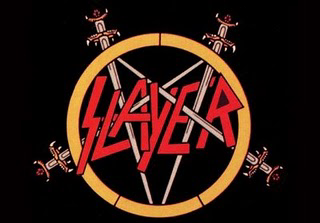


 Autopsy’s barbaric and seminal album Severed Survival offered the listener what would by 1989 arguably represent the nihilistic and amoral apex of the burgeoning death metal genre and thereby cement their place in death metal history. Primitive and raw, the power with which Autopsy frantically bash out these energetic incisions into the human psyche, indicates a desire to transcend and break down the perceived but illusory moral world order and come to terms with the cold harsh realities of existence. On Severed Survival, Autopsy unabashedly presents the listener with a sometimes shocking but nonetheless candid and unmitigated reality, smashing to pieces any presupposition of a cosmic moral world order. As listeners we are forced to come face to face with death, desperation and the unspeakably twisted and cursed elements inherent in the mechanisms of reality and in the collective human consciousness, which Autopsy, like a skilled pathologist expertly dissect and examine. Exhumed are the intense, destructive and “degenerate” elements that are not spoken of in civilized society but which nonetheless drive reality and remain active as motive within the omnipresent but subterranean catacombs of the human mind. Unquestioningly suppressed out fear or an inability to place these depraved realities within the context of our currently constructed, illusory but ubiquitously advocated a priori moral world-view, it is Autopsy who courageously revel in exploring the obscene and who seem bent on destroying illusion in favor of discovering, conforming to and coming to grips with the power of reality.
Autopsy’s barbaric and seminal album Severed Survival offered the listener what would by 1989 arguably represent the nihilistic and amoral apex of the burgeoning death metal genre and thereby cement their place in death metal history. Primitive and raw, the power with which Autopsy frantically bash out these energetic incisions into the human psyche, indicates a desire to transcend and break down the perceived but illusory moral world order and come to terms with the cold harsh realities of existence. On Severed Survival, Autopsy unabashedly presents the listener with a sometimes shocking but nonetheless candid and unmitigated reality, smashing to pieces any presupposition of a cosmic moral world order. As listeners we are forced to come face to face with death, desperation and the unspeakably twisted and cursed elements inherent in the mechanisms of reality and in the collective human consciousness, which Autopsy, like a skilled pathologist expertly dissect and examine. Exhumed are the intense, destructive and “degenerate” elements that are not spoken of in civilized society but which nonetheless drive reality and remain active as motive within the omnipresent but subterranean catacombs of the human mind. Unquestioningly suppressed out fear or an inability to place these depraved realities within the context of our currently constructed, illusory but ubiquitously advocated a priori moral world-view, it is Autopsy who courageously revel in exploring the obscene and who seem bent on destroying illusion in favor of discovering, conforming to and coming to grips with the power of reality.
 On first listen some would easily assume that this release were a mere product of nostalgia of underground metal of the 1980′s, at least indicated so by the production and indication that are present here. However this is death/speed/black metal firmly rooted in the underground
On first listen some would easily assume that this release were a mere product of nostalgia of underground metal of the 1980′s, at least indicated so by the production and indication that are present here. However this is death/speed/black metal firmly rooted in the underground 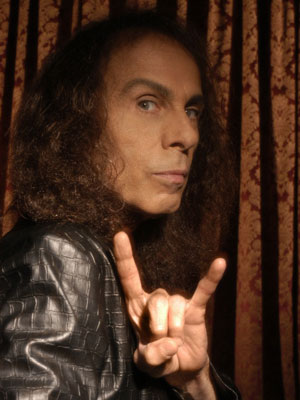
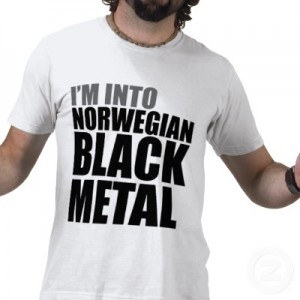 Experience dictates that the modern black metal listener is in essence a “hipster”; a self referential, individualist, egocentric and more or less self-pitying individual. Moreover, experience also dictates that the modern and profane black metal musician has more in common with the lowly pop artist than with the principles and individuals that helped to create the original Norwegian black metal movement.
Experience dictates that the modern black metal listener is in essence a “hipster”; a self referential, individualist, egocentric and more or less self-pitying individual. Moreover, experience also dictates that the modern and profane black metal musician has more in common with the lowly pop artist than with the principles and individuals that helped to create the original Norwegian black metal movement.
 Although such an outright recognition of the Supreme Principle is rarely encountered as explicitly in other black metal bands of the time, the anonymity and symbolism utilized by many of the protagonists within the scene, for example Enslaved and their conscious decision to explore the themes surrounding the Norse gods and the profound metaphysical symbolism implied therein, seems to point to an implicit recognition of higher principles, and perhaps the higher principle itself, from whence an expression of anonymity logically follows.
Although such an outright recognition of the Supreme Principle is rarely encountered as explicitly in other black metal bands of the time, the anonymity and symbolism utilized by many of the protagonists within the scene, for example Enslaved and their conscious decision to explore the themes surrounding the Norse gods and the profound metaphysical symbolism implied therein, seems to point to an implicit recognition of higher principles, and perhaps the higher principle itself, from whence an expression of anonymity logically follows.
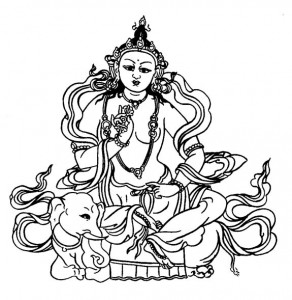 According to Hindu tradition the purpose of life is to become united with the ‘Self’, Brahman, the Supreme Principle, that which is enshrined in the hearts of all, according to ones station in life and capacity to do so. Again, this is the same Supreme Principle alluded to above, from which participation in, a true supra-individual anonymity necessarily springs. Although the original black metal purveyors may not have been consciously aware of the heights to which they were ascending, nor of the full traditional implications of what they were doing, it comes as no surprise that when re-discovering their traditional legends that they would inadvertently ascribe to the goal of, and rediscover some of the outstanding tenants of a more primordial, and complete Indo-European tradition, Hinduism, whose purpose again, much like that of the ancient Norse religion, was and still is to help facilitate the discovery of ‘Self’ knowledge, participation therein and the realization that all proceeds from the Supreme Principle.
According to Hindu tradition the purpose of life is to become united with the ‘Self’, Brahman, the Supreme Principle, that which is enshrined in the hearts of all, according to ones station in life and capacity to do so. Again, this is the same Supreme Principle alluded to above, from which participation in, a true supra-individual anonymity necessarily springs. Although the original black metal purveyors may not have been consciously aware of the heights to which they were ascending, nor of the full traditional implications of what they were doing, it comes as no surprise that when re-discovering their traditional legends that they would inadvertently ascribe to the goal of, and rediscover some of the outstanding tenants of a more primordial, and complete Indo-European tradition, Hinduism, whose purpose again, much like that of the ancient Norse religion, was and still is to help facilitate the discovery of ‘Self’ knowledge, participation therein and the realization that all proceeds from the Supreme Principle.
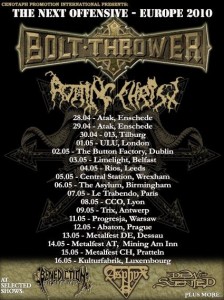 Returning from the brutality of a Bolt Thrower show to recollect the events that defined it brings to mind the task of Ernst Junger, depicting the graphic scenes of martial violence and destruction in his soldier’s memoirs, ‘Storm of Steel’. Not merely the sounds of war and chaos, but the philosophy of death is what one has to confront on such a stage, and this sums up the depth of the Bolt Thrower experience. The great elemental gods of Britannia fired the opening salvo of the evening, unleashing a torrential downpour on the troops to be in attendance once conscripted into the dismal but still functional ULU venue, around the University College London site and home of the un-elite Utilitarian philosophy. A single flash of lightning, probably striking the Cenotaph for the war dead a few minutes away in Whitehall, would indicate that this night belonged to only one elite group, and the slowly multiplying hordes as if signalled to the venue by this storm omen, proved that the headliners were in everybody’s iron sights.
Returning from the brutality of a Bolt Thrower show to recollect the events that defined it brings to mind the task of Ernst Junger, depicting the graphic scenes of martial violence and destruction in his soldier’s memoirs, ‘Storm of Steel’. Not merely the sounds of war and chaos, but the philosophy of death is what one has to confront on such a stage, and this sums up the depth of the Bolt Thrower experience. The great elemental gods of Britannia fired the opening salvo of the evening, unleashing a torrential downpour on the troops to be in attendance once conscripted into the dismal but still functional ULU venue, around the University College London site and home of the un-elite Utilitarian philosophy. A single flash of lightning, probably striking the Cenotaph for the war dead a few minutes away in Whitehall, would indicate that this night belonged to only one elite group, and the slowly multiplying hordes as if signalled to the venue by this storm omen, proved that the headliners were in everybody’s iron sights. In the meantime, some fairly well-known bands would run through comparitively uninteresting sets in order to plug new albums or just an association with Bolt Thrower on this Next Offensive European tour. For the one unknown band, clearly grateful to the Coventry squadron for being able to provide opening infantry support, Ancient Ascendant took to the stage with some confidence and raged through their set infront of the minimal crowd at this time. The sound was not good and the technical setup of the venue’s sonic equipment would be a recurring issue throughout the night, usually leaving bands with an unbalanced sound. Even less impressive was Ancient Ascendant’s music, which was practically educated by the newer schools of Death Metal exclusively, sounding like a more frivolously melodic version of Bloodbath. A lot of generic rhythmic business with some predictably inserted flourishes of lead guitar lines and none of the compositional sense that at the very least ripping-off the old school Death Metal formula would have imbued the songs with by default. Even the next band, The Rotted’s only listenable song was from the older generic Gorerotted project, which is not much less moronic than The Rotted who are really damn retarded in this incarnation, with their stripped down songs consisting of one riff from a later Cryptopsy song played out as blasting Punk music. It’s also quite strange and not recommended to watch old, drugged up men performing breakdowns.
In the meantime, some fairly well-known bands would run through comparitively uninteresting sets in order to plug new albums or just an association with Bolt Thrower on this Next Offensive European tour. For the one unknown band, clearly grateful to the Coventry squadron for being able to provide opening infantry support, Ancient Ascendant took to the stage with some confidence and raged through their set infront of the minimal crowd at this time. The sound was not good and the technical setup of the venue’s sonic equipment would be a recurring issue throughout the night, usually leaving bands with an unbalanced sound. Even less impressive was Ancient Ascendant’s music, which was practically educated by the newer schools of Death Metal exclusively, sounding like a more frivolously melodic version of Bloodbath. A lot of generic rhythmic business with some predictably inserted flourishes of lead guitar lines and none of the compositional sense that at the very least ripping-off the old school Death Metal formula would have imbued the songs with by default. Even the next band, The Rotted’s only listenable song was from the older generic Gorerotted project, which is not much less moronic than The Rotted who are really damn retarded in this incarnation, with their stripped down songs consisting of one riff from a later Cryptopsy song played out as blasting Punk music. It’s also quite strange and not recommended to watch old, drugged up men performing breakdowns. Considered by many as nothing more than a brief distraction, this was soon forgotten as the once powerful entity of Promethean Greek Black Metal took to the stage and the floor swelled with eager hordes. For someone that reveres the older fraction of their catalogue as highly as the Nordic classics, the Rotting Christ set provided both frustrating disappointment but also possibly the biggest surprise of the evening (not the appearance of Diamanda Galas). The transition from ancient Heavy Metal-inflected compositions of blackened mysticism to a boring and cheap form of fast and extreme Rock music with pseudo-cultural embellishments that would make Vangelis either laugh hysterically or summon the wrath of Mars upon Sakis and company, was made quite some time ago when the band sold out to Century Media and although the recent jump to Season of Mist has only marginally improved the quality of their music, the bulk of their songs is blockheaded rhythmic work that wouldn’t sound out of place on a System of a Down joke and disembodied keyboards typical of mainstream Black Metal bands to accompany the minute flickerings of nostalgia that is the signature Rotting Christ melodic style, the same tactic used by fellow Greeks, Septicflesh. Within this disastrous but obviously crowd-pleasing selection of tracks was something quite unexpected given the current direction of the band and their most recent live performances. Almost as though the old spirit of Necromayhem broke free from his sealed confines, the band launched mercilessly into ‘Sign of Evil Existence’, flooding the crowd with a sea of beautiful, extended phrasal work, causing an absolute frenzy and evoking the first old school invocations of the night. Not content with such a brief introduction to arguably the pinnacle of their early discography, ‘Fgmenth, Thy Gift’ continued the magic of ‘Thy Mighty Contract’ with the folky but regal opening riff surging into those magestic, ascendant patterns of guitar. The higher register key of these older songs manipulated the flatness of the sound setup brilliantly, with every note perfectly audible and a memorable contender for song of the entire show.
Considered by many as nothing more than a brief distraction, this was soon forgotten as the once powerful entity of Promethean Greek Black Metal took to the stage and the floor swelled with eager hordes. For someone that reveres the older fraction of their catalogue as highly as the Nordic classics, the Rotting Christ set provided both frustrating disappointment but also possibly the biggest surprise of the evening (not the appearance of Diamanda Galas). The transition from ancient Heavy Metal-inflected compositions of blackened mysticism to a boring and cheap form of fast and extreme Rock music with pseudo-cultural embellishments that would make Vangelis either laugh hysterically or summon the wrath of Mars upon Sakis and company, was made quite some time ago when the band sold out to Century Media and although the recent jump to Season of Mist has only marginally improved the quality of their music, the bulk of their songs is blockheaded rhythmic work that wouldn’t sound out of place on a System of a Down joke and disembodied keyboards typical of mainstream Black Metal bands to accompany the minute flickerings of nostalgia that is the signature Rotting Christ melodic style, the same tactic used by fellow Greeks, Septicflesh. Within this disastrous but obviously crowd-pleasing selection of tracks was something quite unexpected given the current direction of the band and their most recent live performances. Almost as though the old spirit of Necromayhem broke free from his sealed confines, the band launched mercilessly into ‘Sign of Evil Existence’, flooding the crowd with a sea of beautiful, extended phrasal work, causing an absolute frenzy and evoking the first old school invocations of the night. Not content with such a brief introduction to arguably the pinnacle of their early discography, ‘Fgmenth, Thy Gift’ continued the magic of ‘Thy Mighty Contract’ with the folky but regal opening riff surging into those magestic, ascendant patterns of guitar. The higher register key of these older songs manipulated the flatness of the sound setup brilliantly, with every note perfectly audible and a memorable contender for song of the entire show. Benediction were next on stage, an aging group of Death Metal punks fronted by Dave Hunt of Anaal Nathrakh, Mistress and Never Mind the Buzzcocks fame, who nearly talks as much shit on stage as Barney Greenway, including an embarrassing appeasement of some girl’s sob story about a now deceased Benediction fan, thankfully met with a shout of ‘Only death is real’ from the front of the crowd. The set itself was a typically reliable collection of songs spanning most of their discography, better suiting the live environment than on CD, inducing as much violence from the crowd as their primitive, bouncy Death Metal can, like ‘Harmony Corruption’-era Napalm Death meeting ‘Tower of Spite’ by Cerebral Fix. It wasn’t much of a loss to have a guitar cut out during their stint, as the rest of the band seemed to push onwards, building up as much aggression as possible and justifying their placement on the bill, though it was huge relief to hear the end of Benediction at long last, for the lights to dim and the next offensive to commence proper.
Benediction were next on stage, an aging group of Death Metal punks fronted by Dave Hunt of Anaal Nathrakh, Mistress and Never Mind the Buzzcocks fame, who nearly talks as much shit on stage as Barney Greenway, including an embarrassing appeasement of some girl’s sob story about a now deceased Benediction fan, thankfully met with a shout of ‘Only death is real’ from the front of the crowd. The set itself was a typically reliable collection of songs spanning most of their discography, better suiting the live environment than on CD, inducing as much violence from the crowd as their primitive, bouncy Death Metal can, like ‘Harmony Corruption’-era Napalm Death meeting ‘Tower of Spite’ by Cerebral Fix. It wasn’t much of a loss to have a guitar cut out during their stint, as the rest of the band seemed to push onwards, building up as much aggression as possible and justifying their placement on the bill, though it was huge relief to hear the end of Benediction at long last, for the lights to dim and the next offensive to commence proper.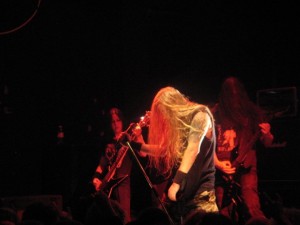 Bolt Thrower commanded the crowd, Karl Willets looked like a war-torn veteran but still yet to be tamed as the ferocity of his vocals didn’t let up for an instant. Jo-Anne Bench is undoubtedly the most menacing female presence in the entire Metal scene, and the poorly balanced sound worked well to render the songs with more bassy fury than can be heard on record. The subtle rhythmic variations of Baz’s guitars on the other hand were not as discernable, but for a seemingly undiscerning crowd, this did nothing to quell the primal violence that tore bones asunder in a ritual of combat replication. The signature riffs were also fairly muted but managed to somehow shine through like the sun between Afghan mountain peaks, and as the band returned for an encore, the perfect choice of songs scorched the stage like a vast napalm attack, with the ominous theme of ‘War’ transforming into ‘Remembrance’ as though the sorrows of Arjuna had been cast aside as he takes to the empty plains of Kurukshetra, seeing the world as it is.
Bolt Thrower commanded the crowd, Karl Willets looked like a war-torn veteran but still yet to be tamed as the ferocity of his vocals didn’t let up for an instant. Jo-Anne Bench is undoubtedly the most menacing female presence in the entire Metal scene, and the poorly balanced sound worked well to render the songs with more bassy fury than can be heard on record. The subtle rhythmic variations of Baz’s guitars on the other hand were not as discernable, but for a seemingly undiscerning crowd, this did nothing to quell the primal violence that tore bones asunder in a ritual of combat replication. The signature riffs were also fairly muted but managed to somehow shine through like the sun between Afghan mountain peaks, and as the band returned for an encore, the perfect choice of songs scorched the stage like a vast napalm attack, with the ominous theme of ‘War’ transforming into ‘Remembrance’ as though the sorrows of Arjuna had been cast aside as he takes to the empty plains of Kurukshetra, seeing the world as it is.
